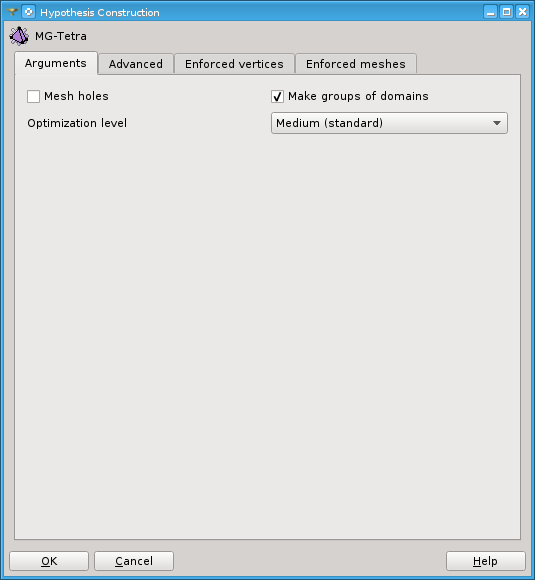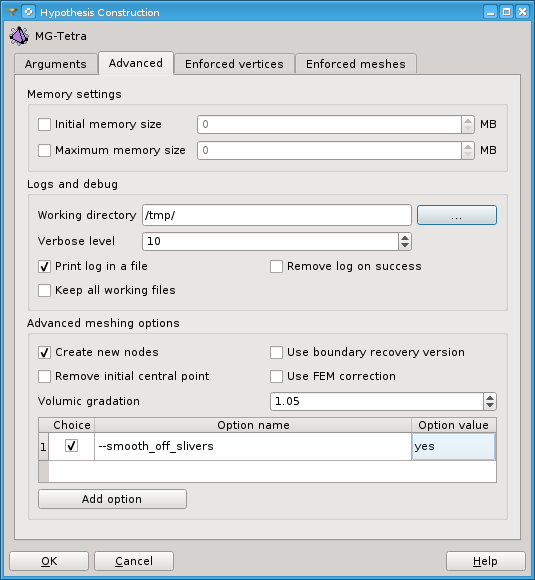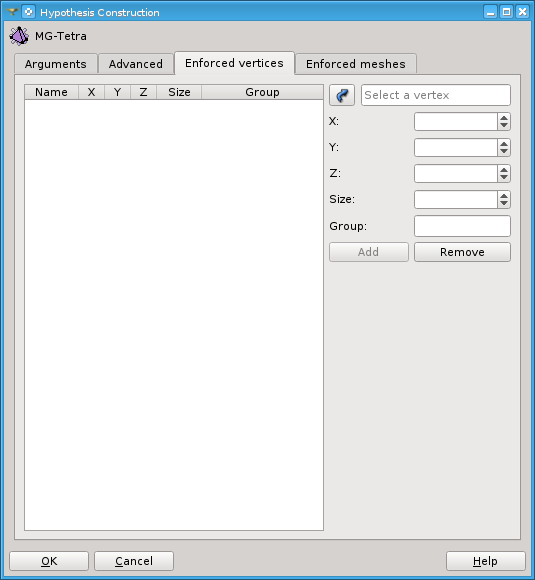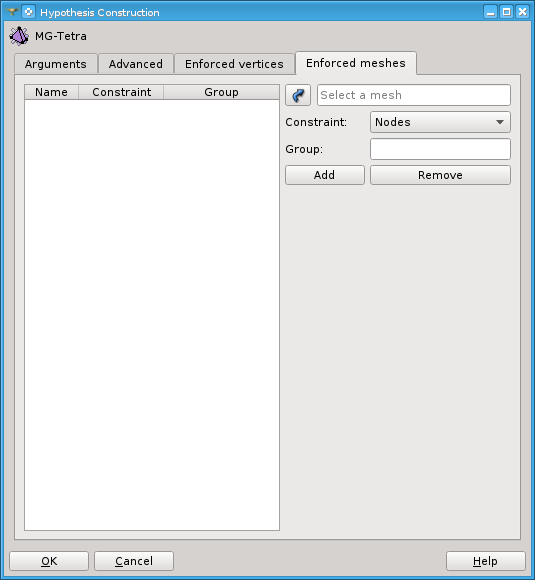MG-Tetra Parameters hypothesis works only with MG-Tetra algorithm. This algorithm is a commercial software.
To get a license, visit http://www.meshgems.com/meshgems-products.html
General parameters
- Name - allows to define the name of the hypothesis (MG-Tetra Parameters by default).
- Mesh holes - if checked, the algorithm will create mesh in the holes inside a solid shape, else only the outermost shape will be meshed. Volumic elements created within holes are bound to the solid.
- Make groups of domains - if checked, the algorithm will create groups of just generated elements corresponding to each mesh domain.
Back to top
Advanced parameters
Memory settings
- Maximum memory size - launches MG-Tetra software with work space limited to the specified amount of RAM, in Mbytes. If this option is checked off, the software will be launched with 7O% of the total RAM space.
- Initial memory size - starts MG-Tetra software with the specified amount of work space, in Mbytes. If this option is checked off, the software will be started with 100 Megabytes of working space.
Logs and debug
- Working directory - allows defining the folder for input and output files of MG-Tetra software, which are the files starting with "GHS3D_" prefix.
- Print log in a file - if this option is checked on the log is printed in a file placed in the working directory, otherwise it is printed on the standard output.
- Remove log on success - if this option is checked on the log file is kept only if an error occurs during the computation. This option is only available if Print log in a file is enabled (there must be a log file to delete it) and Keep all working files is disabled (in this case the log file is always kept).
- Keep all working files - allows checking input and output files of MG-Tetra software, while usually these files are removed after the launch of the mesher. The log file (if any) is also kept if this option is checked.
Advanced meshing options
- Create new nodes - if this option is checked off, MG-Tetra tries to create tetrahedrons using only the nodes of the 2D mesh.
- Remove the initial central point MG-Tetra adds an internal point at the gravity center of the bounding box to speed up and to simplify the meshing process. However, it is possible to refrain from creating this point by using the command line option -no initial central point. This can be particularly useful to generate a volume mesh without internal points at all and in some rare cases at the boundary regeneration phase when it is impossible to proceed with the standard options (for example, when one dimension of the domain is more than 20 times greater than the other two). Use this option if the boundary regeneration has failed with the standard parameters and before using the recovery version (command line option -C). Note: when using this option, the speed of the meshing process may decrease, and the quality may change. Note: the boundary regeneration may fail with this option, in some rare cases.
- Use boundary recovery version - enables using a boundary recovery module which tries to create volume meshes starting from very poor quality surface meshes (almost flat triangles on the surface, high density propagation, extreme aspect ratios, etc.) which fails with the standard version. The resulting volume mesh will however most likely have a very poor quality (poor aspect ratio of elements, tetrahedra with a very small positive volume).
- Use FEM correction - Applies finite-element correction by replacing overconstrained elements where it is possible. At first the process slices the overconstrained edges and at second the overconstrained facets. This ensures that there are no edges with two boundary vertices and that there are no facets with three boundary vertices. MG-Tetra gives the initial and final overconstrained edges and facets. It also gives the facets which have three edges on the boundary. Note: when using this option, the speed of the meshing process may decrease, quality may change, and the smallest volume may be smaller. By default, the FEM correction is not used.
- Volumic gradation - Defines the volumic ratio between 2 consecutive elements. WARNING: Changing the default value of this parameter may dramatically decrease the quality of the resulting mesh.
- A table at the page bottom allows to input in the command line any text for MG-Tetra, for example, advanced options.
Add option - adds a line to the table where you can type an option and its value as text. A check box in the first column activates/deactivates the option of the current row. A deactivated option will be erased upon pressing Ok.
Back to top
Enforced vertices
MG-Tetra algorithm can locally make the mesh finer. It is possible to define enforced vertices in the volume where the mesh will be detailed. A node will be created at the enforced vertex coordinates.
An enforced vertex is defined by:
- A vertex
- from GEOM (Vertex, Compound) - only available on meshes with no geometry attached
- or from (x,y,z) Cartesian coordinates
- A constant physical size. If this size is zero, then the mesh size is not affected.
- If a group name is given, the created node will be added to the group. If the group does not exist, it is created.
Back to top
Enforced Meshes
MG-Tetra algorithm can be forced by other meshes, sub-meshes or groups. The constraint elements should be contained entirely into the solid mesh.
- The constraint element types are:
- If a group name is given, the enforced elements will be added to the group. If the group does not exist, it is created.
See Also a sample TUI Script of the creation of a MG-Tetra hypothesis, including enforced vertices and meshes.
Back to top



